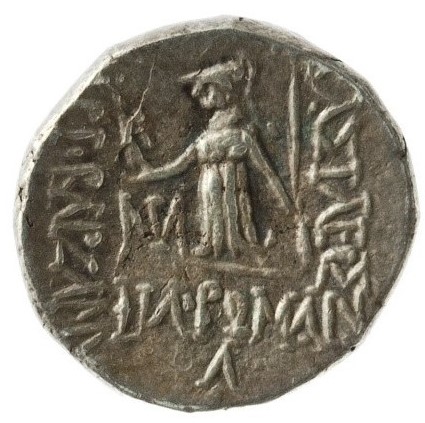Acquisition number: 1985.08
Obv.: Head of Ariobarzanes r., wearing diadem.
Rev.: Athena standing l., holding in right hand Nike (the goddess of victory) l., holding wreath; Athena holds in left hand spear and shield ornamented with Gorgon’s head. ΒΑΣΙΛΕΩΣ ΑΡΙΟΒΑΡΖΑΝ[ΟΥ] ΦΙΛΟΡΩΜΑΙ[ΟΥ] (‘of King Ariobarzanes, friend of Rome’). Dated RY 30 (66/5 BC); Λ (= 30th year of reign) in exergue.
Title: Drachma of Ariobarzanes of Kappadokia (Cappadocia) - 1985.08
Acquisition number: 1985.08
Author or editor: Douglas Kelly
Culture or period: Hellenistic.
Date: c. 66 - 65 BC.
Material: Metal - Silver
Object type: Coins - Greek
Dimensions: 17mm (w)
Origin region or location: Türkiye
Origin city: Mazaca.
Display case or on loan: 5
Keywords: Coin, Greek, Hellenistic, Kappadokia, Cappadocia, drachma, Ariobarzanes, Athena, Nike, Victory, Gorgon, Medusa, Medousa, Rome
O. Hoover, Handbook of Greek Coinage 13 vols (Classical Numismatic Group, Lancaster, PA, 2009-2013), 7.
B.Simonetta, The Coins of the Cappadocian Kings (Fribourg, 1977), 39-42, 45a.
1985.08
Drachma of Ariobarzanes of Kappadokia (Cappadocia)
Silver 3.96 g. 17 mm. c. 66-65 BC.
Obv.: Head of Ariobarzanes r., wearing diadem.
Rev.: Athena standing l., holding in right hand Nike (the goddess of victory) l., holding wreath; Athena holds in left hand spear and shield ornamented with Gorgon’s head. ΒΑΣΙΛΕΩΣ ΑΡΙΟΒΑΡΖΑΝ[ΟΥ] ΦΙΛΟΡΩΜΑΙ[ΟΥ] (‘of King Ariobarzanes, friend of Rome’). Dated RY 30 (66/5 BC); Λ (= 30th year of reign) in exergue.
The ancient kingdom of Kappadokia had fluid boundaries throughout its history but was roughly the same as the region of the same name in central Turkey, well known to the modern tourist for Göreme and its surrounds. In the confusion resulting from the collapse of Persian rule in Asia Minor during Alexander the Great’s conquest, the local satrap Ariarathes I (reigned 333-322 BC) established his own independent kingdom in Kappadokia. Makedonian forces defeated him and crucified him with all his family, except one son of the same name who escaped and regained the kingdom c. 300 BC.
The line of kings descended from Ariarathes I lasted down to 101 BC. To prevent Mithradates Eupator, king of Pontus, from taking over the kingdom (Mithradates had installed his eight-year old son on the Kappadokian throne as Ariarathes IX), the Roman senate sponsored Ariobarzanes as the best available candidate.
His reign was a series of expulsions followed by Roman restorations, which may be tabulated as follows:
93 BC: expelled by Tigranes of Armenia
92 BC: restored by Sulla
91 BC: expelled by Tigranes of Armenia
91 BC: restored by Aquilius
90-89 BC: expelled by Mithradates Eupator
84 BC: restored by Curio acting on Sulla’s behalf
82 BC: expelled by Mithradates
81 BC: restored by Licinius Murena
74 BC: expelled by Mithradates
71 BC: restored by Lucullus
67 BC: expelled by Mithradates Eupator and Tigranes
66 BC: restored by Pompey.
In 63 BC, at the time of Pompey’s final reorganization of the eastern provinces, in the presence of Pompey himself, Ariobarzanes abdicated in favour of his son, Ariobarzanes II (reigned 63-52 BC).
Ariobarzanes I took the title of Philoromaios, ‘Friend of Rome’, as did his grandson Ariobarzanes III (reigned 51-42 BC). These kings are referred to by the modern term ‘client kings’. Nominally independent, these kings were friends and allies of the Roman people but in fact relied upon Roman approval and support and needed to be assiduous in showing gratitude to the Roman state and to the leading men at Rome who took up their interests.
The Kappadokian drachma was progressively reduced in weight over the history of the kingdom. Simonetta, 10, calculates the average weight of the drachmas of Ariobarzanes I as 3.93 g. This is based on a count of 48 coins, with a minimum of 2.77 g. and a maximum of 4.30 g. This range illustrates the variation of weights that can occur in Greek coinage. Our coin, struck towards the end of the reign weighs 3.96 g., close to average weight.
O. Hoover, Handbook of Greek Coinage 13 vols (Classical Numismatic Group, Lancaster, PA, 2009-2013), 7.
B.Simonetta, The Coins of the Cappadocian Kings (Fribourg, 1977), 39-42, 45a.

